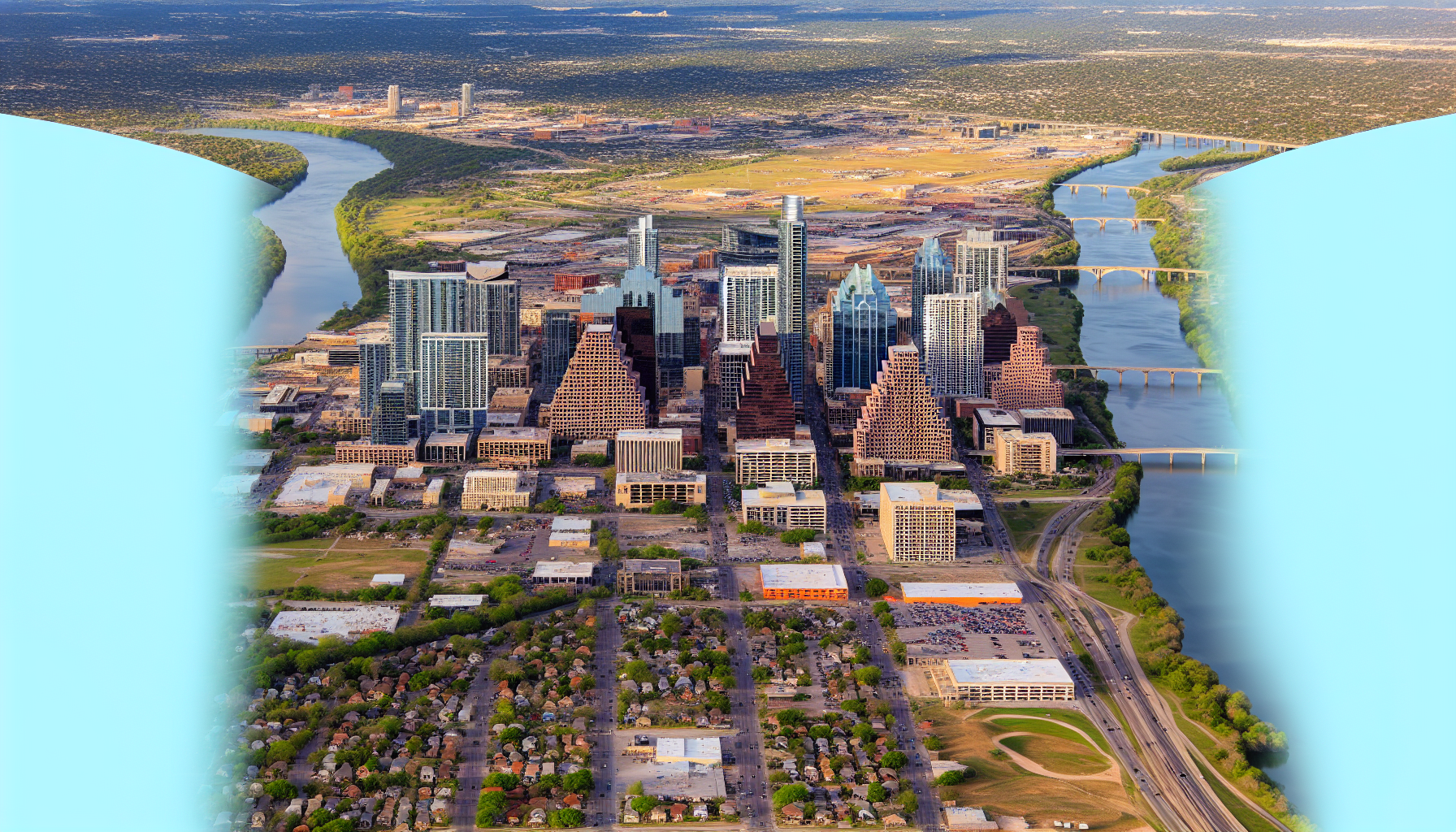Top Insights on Moving from California to Austin, TX: Pros, Costs, and Family Life

Mar 13, 2024
If you’re considering moving from California to Austin, TX, you’re probably questioning the trade-offs. This article serves as your straightforward guide, detailing the financial perks, career prospects, and lifestyle transitions you’ll face when moving from California to Austin, TX. Expect candid assessments of living expenses, the dynamic job market, particularly in tech, and the cultural tapestry that defines Austin, all while enjoying the cost benefits of no state income tax. Get ready for a clear-eyed view on transitioning to Austin’s life, without the fluff.
Key Takeaways
- Austin, TX is attracting Californians due to its lower cost of living, absence of state income tax, affordable housing, and a competitive job market with marked growth in the tech sector, dubbed ‘Silicon Hills’.
- Austin provides an active lifestyle with numerous outdoor activities, a vibrant cultural scene with food diversity and music festivals, and roughly 300 sunny days annually, albeit with more extreme weather compared to California.
- Relocating to Austin requires careful consideration of moving costs, with professional movers averaging $5,500 for a three-bedroom home move and the best times to move being off-peak seasons for potential savings.
Why Californians Choose Austin

More and more Californians are swapping life in the Golden State for Texas, especially Austin. This city presents a compelling combination of reasonable living costs, a booming job market, and an energetic way of life, making it an attractive alternative for those departing from celebrated California cities such as San Francisco and San Diego.
Affordable Living
Austin’s financial allure is undeniable, particularly in contrast to California’s steep living expenses. Median gross rent in Austin remains markedly more affordable than the substantial rates found within California’s principal metropolitan areas, like the Bay Area.Texas’ lack of state income tax presents a considerable attraction for both individuals and investors, proposing noteworthy economic benefits that extend into property taxes as well. Alongside reduced prices on fundamental needs such as food and an appealing sales tax rate, Austin emerges as an economically attractive option for those considering relocation from California.
Thriving Job Market

The tech sector in Austin is experiencing a significant boom, with job growth surging by 41.4% from 2015 to 2020. The city has attracted heavyweights such as Apple and Dell, leading to its moniker ‘Silicon Hills’ because of these substantial presences.
Austin is not only appealing for established entities but also boasts a thriving startup scene, placing it at the impressive global rank of 11th. Government incentives like the absence of corporate income tax coupled with an expanding space technology industry have positioned Austin as a prime destination for both pioneering tech companies and those seeking employment opportunities within this vibrant cityscape.
Active Lifestyle & Outdoor Activities

The attraction to Austin is not just rooted in its economic prospects. Its dynamic way of life, marked by a plethora of outdoor pursuits and scenic wonders, plays a big role in drawing people from California. Activities that Californians relish, such as cycling, running, paddling kayaks, and taking dips, can all be found in abundance within the city.
The sort of active lifestyle cherished by Californians finds a seamless match in Austin and San Jose, two municipalities located on the West Coast of the state.
Austin’s array of parklands and bodies of water, paired with its closeness to Texas’ hill country, provides an extensive canvas for those keen on outdoor activities. From ambling through picturesque rolling hills to observing avian life amidst diverse habitats, Austin caters to an assortment of nature-related hobbies.
Comparing California and Austin, TX: Pros and Cons
Certainly, Austin possesses a certain charm, yet it’s essential to consider both its benefits and drawbacks thoroughly. Examining aspects such as the cost of living, employment opportunities, and weather conditions in detail can help you make a well-informed decision.Cost of Living Comparison
Austin is a standout choice for those seeking low-cost living. It offers significantly lower expenses across the board—housing, utilities, groceries, and transportation—all of which cost less than in California. To illustrate this point, consumer prices without rent are 16.0% higher in Los Angeles compared to Austin. With rent included, they’re still 15.4% higher.The savings continue when examining specifics like transportation and utility costs.
- The price of a monthly transit pass in Los Angeles exceeds that of one in Austin by an eye-opening 85.5%
- Filling up your car’s tank will hit your wallet harder as gasoline prices soar at a rate of 74.3% more expensive
Despite utilities being somewhat more expensive in Austin, the city maintains its advantage with an overall lower cost of living to mitigate these smaller disparities.
Job Opportunities
Austin’s job market is not as competitive as that of California, yet it still provides an abundance of opportunities, especially in lucrative areas such as technology and innovation. The fusion of a robust job market with a lower cost of living makes Austin an attractive option.The city is currently undergoing significant economic growth, which has been brought into focus by Elon Musk’s relocation and his pronouncement naming Austin the most substantial ‘boomtown’. America has witnessed this in 50 years. These kinds of affirmations emphasize the expanding job opportunities within the city.
Weather & Climate
With approximately 300 days basking in the sun annually, Austin radiates a level of sunshine akin to that of California. Yet, it distinguishes itself with higher humidity and more pronounced extremes in temperature, including periods of extreme heat.When comparing the allure of Austin’s weather to that familiar to Californians, several distinctions emerge.
- In July, for instance, average highs in Austin soar to near 95 degrees Fahrenheit, surpassing Los Angeles’ milder high average by about 11 degrees.
- Instances of extremely hot temperatures are more common in Austin.
- On another note, although both cities enjoy an abundance of sunny days, they share them equally. Precipitation is heavier in Austin than in LA.
Moving Costs and Considerations
We now shift our focus to the pragmatic elements of moving, which include an examination of the costs involved and vital considerations that must be taken into account after recognizing why Austin holds such an attraction.Professional Movers vs. DIY
The process of moving can be quite demanding, and an initial choice to consider is opting for professional movers as opposed to handling the move on your own. Professional movers provide ease but at a steeper price. For example, the average cost for a long-distance relocation of a three-bedroom residence typically hovers around $5,500.Alternatively, conducting the move yourself with rental trucks or portable moving containers might present more economical advantages, particularly for less extensive relocations. Nevertheless, it’s important to deliberate on the exertion and hours required in self-managed moves and decide if these savings truly compensate for such demands.
Packing and Storage Solutions
Moving containers and storage units can be advantageous for packing and storing needs. If you’re relocating from California to Austin, the price of moving containers ranges from $988 to $2,530 for smaller moves, with costs going up as the move gets larger. These options add convenience by allowing for temporary holding places if needed during your transition.On another note, renting a moving truck is an economical choice, but it requires more personal labor since it involves self-packing and driving. For short-term storage of items, consider storage units that have monthly fees between $75 and $300, depending on the size necessary.
Timing Your Move
Opting to relocate during the winter months, which is considered the off-peak season for moving, may result in a reduction of expenses. Conversely, choosing to move during the autumn can escalate costs by up to 40% over what you might pay if you moved in winter.For those looking to secure their preferred dates and potentially save money through more advantageous rates, booking a moving company well in advance—specifically two to three months prior—is recommended. Scheduling your move on weekdays rather than weekends could lead to savings due again as there’s lower demand on these days.
Settling Down in Austin: Family Life, Education, and Housing
We will now explore life in Austin post-relocation, delving into aspects of family living, the educational landscape, and the real estate scene.Family-Friendly Neighborhoods
Austin provides a balanced blend of urban and suburban life, perfect for families seeking affordable housing, quality education, and safety. The city’s top family-friendly neighborhoods like Rollingwood, West Lake Hills, and Brushy Creek stand out with their strong community atmosphere and a plethora of amenities suitable for families. Crestview, Round Rock, and Hudson Bend also offer a warm community feel along with convenient access to various shopping and dining options. Each of these areas in Austin is known for creating an environment that addresses the needs of family living.Education and Schools
Prioritizing education, Austin meets the expectations of families with an array of academic options. This city offers 94 public schools across elementary and middle levels, along with high schools, 113 private institutions, and six higher education colleges or universities.The public high school infrastructure in Austin boasts inclusion on the prestigious U.S. News & World Report’s Best High Schools list for 58 of its schools. The presence of a leading institution like the University of Texas plays a vital role in fostering a highly educated workforce within Austin’s thriving tech industry.
Housing Market and Real Estate
The real estate market in Austin offers greater affordability compared to many regions of California, as evidenced by the median home price falling 8.4% to $424,450 and average property values dipping by 9.2% to $455,424. Such changes suggest a trend towards more economically accessible housing choices in the city, possibly affected by Austin’s typical earnings when measured against the country’s national income.Austin is considered an attractive destination for those looking at investing in property due to:
- Its burgeoning population
- Robust economic standing
- Variegated job market
- Texas not levying any state income tax
There is a robust rental sector within Austin’s real estate landscape, with growth observable and numerous types of properties on offer.
Embracing Austin's Culture and Lifestyle
Moving to Austin isn’t merely about the logistics. It’s also an opportunity to dive into a vibrant way of life that reflects the unique culture of Texas.We’re going to explore Austin’s diverse food scene, its standing as a central hub for live music, and its fondness for enjoying activities in the great outdoors.
Culinary Scene
Austin’s culinary scene is a feast for food lovers. The city offers a dynamic mix that includes:- Traditional Texas dishes
- Mexican cuisine
- International foods
- Innovative vegetarian options
In addition to its variety of food, Austin is also known for its quality craft beer, a testament to its thriving and innovative beverage industry. So whether you’re a foodie or a craft beer enthusiast, Austin’s culinary scene has something for everyone.
Entertainment and Live Music
Known as the ‘Live Music Capital of the World,’ Austin serves as a center for an array of music festivals and gatherings that honor various musical styles. The city is home to prominent events such as:- South by Southwest (SXSW)
- Austin City Limits Music Festival
- Pecan Street Festival
- Austin Blues Festival
Breweries in Austin have gained recognition as prime spots for enjoying live music outdoors. Establishments like Jester King, Vista Brewing, The ABGB, and Meanwhile Brewing deliver distinctive experiences where crafted beer meets entertainment, enriching the cultural landscape of this vibrant city.
Outdoor Attractions and Nature
Austin serves as an idyllic destination for those who have a passion for the outdoors. The city captivates with its lush foliage and picturesque scenery, offering numerous parks and trails that cater to a variety of activities, including running, walking, hiking, and biking.In neighborhoods such as Old Enfield, Lakeway, and Rosedale, you’ll find a myriad of outdoor pursuits at your fingertips.
Aquatic attractions like Lady Bird Lake provide unique experiences like bat-viewing cruises at sunset, along with kayaking and water biking adventures. For swimming enthusiasts looking for natural settings within the city limits, there’s Barton Springs Pool or Deep Eddy Pool to indulge in. Austin stands out as an ultimate sanctuary for those who revel in nature-filled escapades.
Summary
Austin presents a compelling blend of affordability, employment prospects, and a dynamic culture that is luring Californians to the city. The allure lies in Austin’s booming job market, its cost-effective standard of living, and its energetic cultural landscape—a combination that positions it as an attractive option for those considering moving there.Frequently Asked Questions
Why are people moving from California to Austin?
Individuals are relocating from California to Austin, Texas, in an effort to save money through more economical housing opportunities and reduced tax burdens. With its flourishing real estate market, Austin provides less expensive housing solutions, while the state of Texas benefits residents with lower state income and sales taxes than those found in California.Is it worth moving to Texas from California?
Relocating from California to Texas may offer financial benefits, including a reduced cost of living, the absence of state income tax, and more affordable housing prices, which could be advantageous for individuals seeking economic improvements.Is Austin cheaper than California?
Indeed, residing in Austin is typically less expensive than living in California. The cost of living in Austin is between 12% and 32.3% lower than it is in Los Angeles.Consequently, to sustain an equivalent quality of life that one would have in California, a smaller amount of money would be required if you were based in Austin.
What job opportunities does Austin offer?
The bustling tech sector in Austin is experiencing significant expansion, presenting a wealth of job opportunities. This growth is bolstered by the presence of major players such as Apple and Dell.For those considering a change in their career path, the industry’s prospects within this city are worth exploring.
How does Austin's weather compare to California's?
Despite Austin and California sharing a comparable amount of sunshine, Austin’s weather is notably distinct due to its more extreme temperature variations and elevated humidity levels.- Categories
- City Guides |
- Relocation Guides



